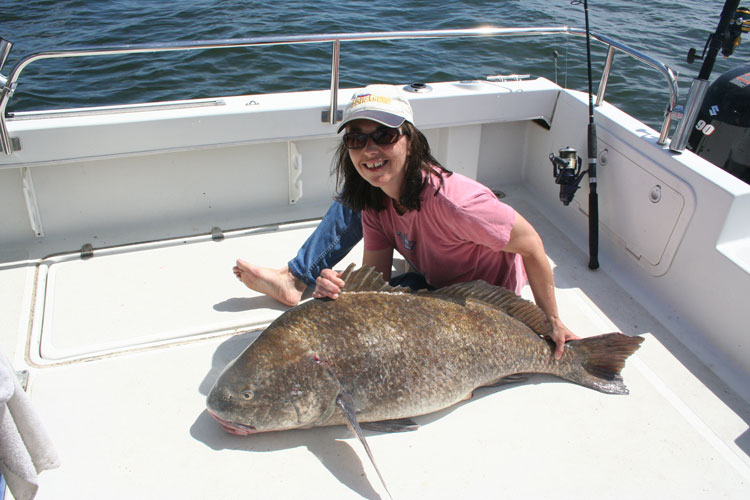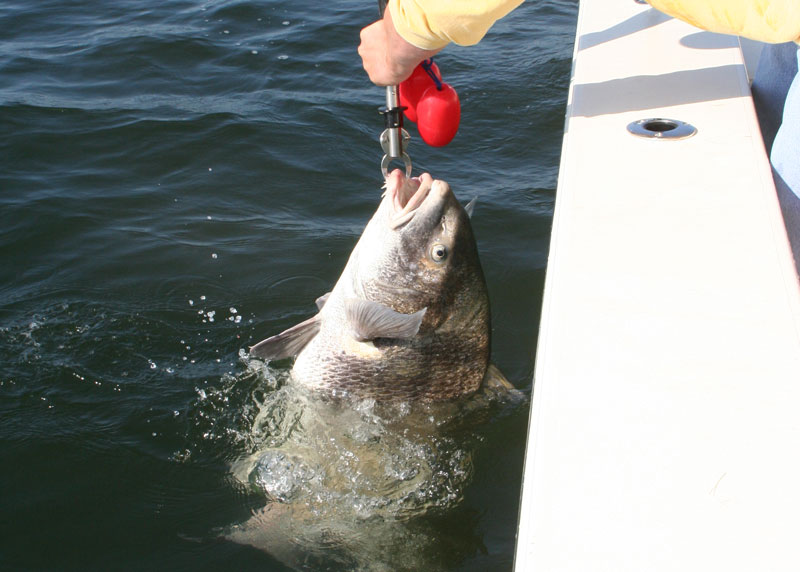Many of the black drum caught in the Mid-Atlantic this season will top 50 pounds, a 90-pound fish or two will surely be caught, and some lucky angler out there could peg the 100 mark. The Maryland record is 103 pounds, eight ounces, and in the Delaware Bay, a 113-pound black drum sets the bar. That same fish also holds the IGFA world record, so the black drum run also offers a very real opportunity to set an all-tackle world record while fishing in the Mid-Atlantic region. Want to give these big bruisers a shot? Here’s how and where to go about it.

- Target this species early in the year, when they’re schooled up tight. They’ll make a showing in the Delaware Bay, the lower Chesapeake, and along the coastal inlets at some point during April most seasons, and in the middle Chesapeake by mid to late May. Once the runs begin, however, the fish only stick close together for a few weeks before thight schools break up into smaller pods which are a lot harder to find.
- Rig up a 30-to 50-pound class rod with a fishfinder rig attached to a four or five foot 60-pound fluorocarbon leader, terminating in a 8/0 to 10/0 circle hook.
- Bait the hook with a half of a fresh soft or peeler crab, sea clams, or crushed mussels, and weight it with however much you need to hold bottom close to the boat.
- When a drum takes the bait, give it a three- to five-count with the reel in freespool before applying any tension. As usual with circle hooks, a slow application of pressure is more apt to lead to solid hook-ups than suddenly locking down on the fish. Black drum have sensitive mouths and will feel the tension of the weight—and often spit it—so make sure there’s zero tension on the line when they initially take off. Expect several blistering runs before the fish tires. Once it does, bring it up to boat-side, take your pictures (and send them in to FishTalk, of course) and un-hook the fish in the water if at all possible, to minimize stress.
- Remember that big black drum are often riddled with worms, and aren’t very good to eat. If you catch one under 20 pounds it can be quite tasty, but fish bigger than this really should be set free.
Depending on what area you fish in, boat-handling tactics can vary quite a bit. In the Delaware and coastal inlets most people anchor up, set their baits, and wait. In the lower Chesapeake, many people target drum by slowly probing around the islands of the CBBT. And in the middle Chesapeake, anglers slowly drive up and down the drop-off at the Stone Rock and similar areas, and wait to locate fish on the meter before they ever drop a line. Recognizing them is easy, since they make huge red triangles on your fishfinder screen. Another way to locate these big blacks (yes, it is cheating) is to look around the area with binoculars and watch for boats with bent rods. Remember, when they’re schooled up these fish are tightly-packed, and where there’s one, there are many.

BONUS TIP: Catch one black drum, and you can “jug” the fish to mark the school. Attach a small hook to a length of line with a plastic milk jug tied to the end, put it on the fish, and set it free. In a matter of minutes the drum will rejoin the school—and you can follow that jug to strike after strike. But don’t do it when there are a lot of boats in the area or you’ll just end up combat-fishing. And of course, after you've had your fill be sure to retrieve your jug and line.
Editor's note: This article was originally published in February of 2017 and was last updated in June of 2024.